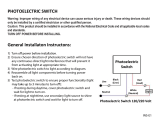
SA1E Miniature Photoelectric Switches (Built-in Amplifier)
18
1. Indicator and Output Operation
(except for background suppression model)
•The operation LED turns on (yellow) when the control output is on.
Stable LED (green)
ol
•The stable LED turns on (green) either at stable incident or stable interrup-
tion. Make sure to use the photoelectric switch after the stable operation
is ensured.
•In the light ON operation, the output turns on when the receiving light inten-
sity level is 1.0 or over as shown on the right.
•In the dark-ON operation, the output turns on when the receiving light in-
tensity level is 1.0 or less as shown on the right.
Receiving Light Intensity
Level
Light Receiving
Status
Stable
LED
(green)
Operation LED (yellow)/Control
Output
Light ON Dark ON
Operation
Level
1.2 and
over
Stable Incident ON
ON OFF
1.0
Unstable
Incident
OFF
Unstable
Interruption
OFF ON
0.8 and
below
Stable
Interruption
ON
2. Optical Axis Alignment (Light ON)
Through-beam
Fasten the receiver temporarily. Place the projector to face the receiver. Move
the projector up, down, right and left to nd the range where the operation
LED turns on. Fasten the projector in the middle of the range. Next, move the
receiver up, down, right and left in the same manner and fasten in the middle
of the range where the operation LED turns on. Make sure that stable LED
turns on at stable incident and stable interruption.
Polarized retro-reective
Install the reector perpendicularly to the optical axis. Move the SA1E
photoelectric switch up, down, right and left to nd the range where the
operation LED turns on. Fasten the switch in the middle of the range. Polarized
retro-reective model can be installed also by nding the position where the
reection of projected red light is most intense, while observing the reection
on the reector from behind the switch. Make sure that stable LED turns on
at stable incident and stable interruption.
Diffuse-reective/Small-beam reective
Place the SA1E photoelectric switch where the switch can detect the object.
Move the switch up, down, right and left to nd the range where the operation
LED tuns on. Fasten the switch in the middle of the range. Make sure that
stable LED turns on at stable incident and stable interruption. Because the
light source element of small-beam reective model is a red LED, visual
inspection is possible as well.
3. Sensitivity Adjustment
Referring to the table at right, adjust the sensitivity of the SA1E photoelectric
switch when necessary, in such cases as the through-beam model is used
to detect small or translucent objects or the reective model is affected
by background. The table explains the status of operation LED when the
operation mode is set to light ON.
•After adjusting the sensitivity, make sure that stable LED turns on at stable
incident and stable interruption. For detecting objects too small to turn on
the stable LED, use an optional slit.
•Sensitivity is set to the maximum (+) at the factory before shipment. When
adjusting the sensitivity, use the screwdriver supplied with the SA1E pho-
toelectric switch to turn the control as shown below, to a torque of 0.05
N·m maximum.
Step
Photoelectric
Switch Status
Sensitivity Control Adjusting Procedure
1
Receiving light
•Through-beam,
polarized reective: No
object detected
•Diffuse reective,
small-beam reec tive:
Object detected
Turn the control counter-clockwise to
the mini mum (–). Then turn clock wise
(toward +) until the operation LED
turns on (turns off with dark ON type)
(point A).
2
Light is interrupted
•Through-beam,
polarized reective:
Object detected
•Diffuse reective,
small-beam reec tive:
No object detected
At interruption status, turn the control
clock wise (toward +) from point A, until
the operation LED turns on (turns off
with dark ON type) (point B).
If the operation LED does not turn
on (turn off with dark ON type) even
though the control has reached the
maxi mum (+), set the maximum
position (+) as point B.
3
—
Set the middle point between point A
and B as point C.
4. Adjustment of Sensing Range for Background
Sup pression (BGS) Model
•When adjusting the sensing range, follow the instruction below.
Step Distance Control Adjusting Procedure
1
Install the photoelectric switch and the object rmly.
Turn the control counterclockwise until the operation
LED turns off (turns on with dark ON type). From this
point, turn the con trol clockwise until the operation
LED turns on (turns off with dark ON type) (point A).
2
Remove the object, and conrm that the operation
LED turns off (turns on with dark ON type). Turn the
control clockwise until the operation LED turns on
(detecting the back ground) (turns off with dark ON
type) (point B). (Note 1)
3
Set the middle point between point A and B as point
C. (Note 2)
Note 1: When the background is far off and not detected, turn the control 360°,
and set the point as point C.
Note 2: Because the control is multi-turn, it may take more than one turn to
move from point A to point B.
Note 3: Turning the control clockwise lengthens the sensing dis tance.
Note 4: Background suppression (BGS) model is not provided with a stable LED.
Operation LED (yellow)
(Note 3)
Sensing Range Control
(6-turn)
(Note 4)
Operating Instructions























